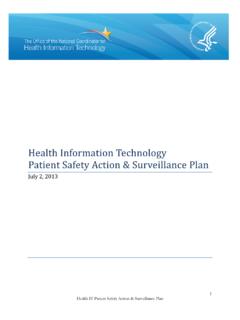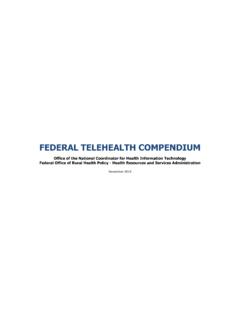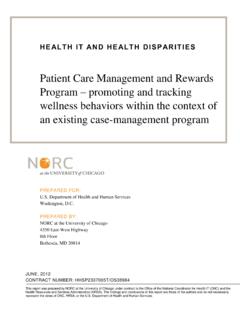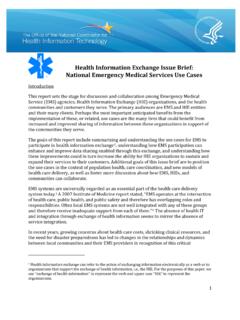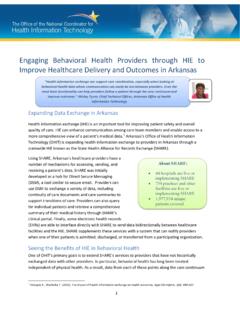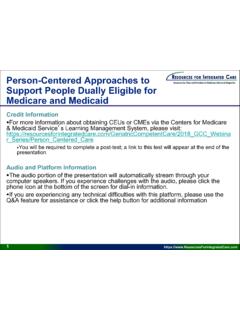Transcription of Designing The Consumer-Centered Telehealth & eVisit …
1 Designing The Consumer-Centered Telehealth & eVisit experience Considerations for the Future of consumer Healthcare W H I T E P A P E R Prepared for The Office of National Coordinator for Health Information Technology Department of Health & Human Services Prepared by Kyra Bobinet, MD MPH John Petito, MS Special thanks to Greg Billings, CTeL,for key input and contribution ii SUMMARY This white paper covers key elements of design for Consumer-Centered Telehealth . Given the rapid growth of Telehealth and overall disruption of healthcare reimbursement and care delivery, the Office of the National Coordinator for Health Information Technology (ONC) commissioned a design session focused on this topic on April 10, 2015 with over 30 stakeholders in attendance.
2 Key findings from this design session include the following guidelines for a Consumer-Centered Telehealth experience : 1. There cannot be friction for the user. 2. Team-based care must include smart triggers. 3. Real world and online world must converge. 4. We must be sensitive to data overload. 5. Consumers are the hubs of their own healthcare data. 6. Converge data for interactions to be safe and meaningful. 7. Expand role for care team based on new data triggers. 8. Integrate technology and human interaction in the physical world. 9. Increase focus on patient data security.
3 In addition, and while not necessarily endorsed by ONC, several issues were raised that warrant further exploration and consideration: First, Telehealth is seen as a means to scale quality, lower cost, and increase convenience, however, integration of data back to the primary health record is needed to avoid fragmenting care and potentially impacting patient safety. Second, Consumer-Centered Telehealth technologies are rapidly evolving to meet the on-demand economy expectations of consumers, which potentially offers them greater control over their health and data.
4 Third, consumers must own and have access to their data and fully integrated Telehealth may offer this access, especially important for more disenfranchised, vulnerable, or rural populations. Finally, interoperability efforts are essential to keep pace with the proliferation of Telehealth solutions that are finding their way to consumers. The ONC efforts around this, as well as Blue Button, moving forward would assist in secure and safe data support to this rapidly evolving field. iii CONTENTS Design Session Structure of Design Changing Telehealth An Industry Defining Integrated vs.
5 Fractured Care and Challenges Identified from the Consumer-Centered Telehealth Design Future State: Consumer-Centered Telehealth Design Principles 1 INTRODUCTION The Office of the National Coordinator for Health Information Technology (ONC) engaged the behavior design firm, engagedIN, to conduct background research and facilitate a design session with leading experts in health information technology (health IT) and Telehealth . The goal of this session was for the ONC to develop an informed perspective on the design and behavioral considerations for Consumer-Centered Telehealth , This white paper was written to reflect the findings from this research, as well as novel solutions and forward thinking recommendations created during the live design session.
6 The ONC was primarily interested in better understanding the potential of Telehealth capabilities to enable a Consumer-Centered healthcare ecosystem. Both background research and the design session findings point to the future for Telehealth -enabled care delivery as bright. There has been a significant amount of innovation from vendors and startups as industry stakeholders (including employers, providers, and payers) have embraced, and consumers have become increasingly open to, new care delivery models. These new models have the potential to increase convenience, improve access and better manage costs.
7 Industry associations such as the American Telemedicine Association (ATA), the Alliance for Connected Care, and the Center for Telehealth and e-Health Law (CTeL), have proposed thoughtful approaches to define and structure these new care modalities, and their work can be instructive for policy makers and Finally, ensuring a safe and convenient integration of Telehealth into mainstream care requires significant forethought and strategic planning. This implies engaging representatives of relevant stakeholders to co-design the Telehealth -enabled delivery system of the future.
8 This white paper, although touching upon many aspects of the current state regulatory and technological ecosystem of Telehealth , is not to be interpreted as a definitive assessment of the Telehealth landscape. It also is not meant to be interpreted as a policy statement about the ONC s position on Telehealth . Rather, it provides: a) an overview of the purpose, structure, and frameworks used to facilitate the design session, b) a cursory evaluation of the current state Telehealth landscape (as implicated by output from the design session), c) current state challenges resolved with future state designs, and finally, d) a review of the principles for future Telehealth design that were highlighted by design session participants.
9 1 #.VVBEwUIzpiM 2 DESIGN SESSION BACKGROUND As part of its mission, ONC aims to coordinate the adoption and use of health IT to support broader objectives of integrating data and continuity across diverse care delivery models towards better health outcomes. Additionally, the draft Federal Health IT Strategic Plan (2015-2020), for which ONC has made commitments, includes a stated goal to expand the adoption and use of a broader set of technologies, including Telehealth and mobile health. Telehealth adoption is further underscored and encouraged in the Connecting Health and Care for the Nation: A Shared Nationwide Interoperability Roadmap2.
10 This design session provided an opportunity to gather subject matter experts, and develop an understanding of current and future novel use cases for Telehealth , At the request of the ONC, engagedIN held a half-day session on Designing the Consumer-Centered Telehealth experience . Hosted at the Department of Health and Human Services headquarters in Washington, DC on Friday, April 10th, 2015, the session included over 40 private and public-sector stakeholders with representatives from consumer , provider, payer, vendor, health IT organizations, and other federal agencies (Appendix A).


